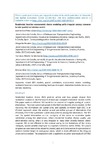Mostrar o rexistro simple do ítem
Residential Location Econometric Choice Modeling With Irregular Zoning: Common Border Spatial Correlation Metric
| dc.contributor.author | Pérez-López, José-Benito | |
| dc.contributor.author | Novales, Margarita | |
| dc.contributor.author | Varela-García, Francisco-Alberto | |
| dc.contributor.author | Orro, Alfonso | |
| dc.date.accessioned | 2021-10-13T15:26:02Z | |
| dc.date.available | 2021-10-13T15:26:02Z | |
| dc.date.issued | 2020 | |
| dc.identifier.citation | Pérez-López, JB., Novales, M., Varela-García, FA. et al. Residential Location Econometric Choice Modeling with Irregular Zoning: Common Border Spatial Correlation Metric. Netw Spat Econ 20, 785–802 (2020). https://doi.org/10.1007/s11067-020-09495-5 | es_ES |
| dc.identifier.issn | 1572-9427 | |
| dc.identifier.uri | http://hdl.handle.net/2183/28607 | |
| dc.description.abstract | [Abstract] Residential location choice (RLC) predicts where and how people choose their residential location in the framework of land use–transport interaction models (LUTI). This paper seeks an efficient RLC model in the context of irregular zoning of location alternatives. The main current proposals in the field are discrete choice models. In RLC modeling, the alternatives are spatial units, and spatially correlated logit (SCL) is an efficient approach when the analyst cannot pre-define groups of alternatives that efficiently reflect the systematic substitution patterns among the alternatives. The SCL uses the spatial information on the contiguity of the zones to determine spatial correlation among the alternatives. Urban residential location choice usually uses administrative zoning, which is very irregular in many cities (mainly historic cities); however, SCL is not efficient in this context owing to the limitations of the binary contiguity spatial variable employed as a spatial correlation metric (SCM). This paper proposes an extension of the mixed SCL model, with an SCM based on the proportion of common border length in contiguous zones, which is more efficient in the irregular urban zoning context. The proposed model is applied to an urban case study of LUTI RLC modeling with irregular zoning, based on the administrative divisions of the city of Santander (Spain) and is shown to be empirically more efficient than the previous approaches. | es_ES |
| dc.description.sponsorship | The authors acknowledge the financial support provided by the Government of Spain under the projects TRA2012-37659 and RTI2018-097924-B-I00 MCIU/AEI/FEDER, UE | es_ES |
| dc.language.iso | eng | es_ES |
| dc.publisher | Springer Nature | es_ES |
| dc.relation | info:eu-repo/grantAgreement/MINECO/Plan Nacional de I+D+i 2008-2011/TRA2012-37659/ES/MODELO AVANZADO DE INTERACCION ENTRE USOS DEL SUELO Y SIATEMAS DE TRANSPORTE/ | |
| dc.relation | info:eu-repo/grantAgreement/AEI/Plan Estatal de Investigación Científica y Técnica y de Innovación 2017-2020/RTI2018-097924-B-I00/ES/PARADAS, TRANSBORDOS Y RESERVA DE PLATAFORMA. ANALISIS EXPERIMENTAL Y MODELIZACION DE SU INFLUENCIA EN SISTEMAS DE AUTOBUS/ | |
| dc.relation.uri | https://doi.org/10.1007/s11067-020-09495-5 | es_ES |
| dc.rights | This is a post-peer-review, pre-copyedit version of an article published in Networks and Spatial Economics (2020) 20:785–802. The final authenticated version is available online at https://doi.org/10.1007/s11067-020-09495-5 | es_ES |
| dc.subject | Mixed GEV models | es_ES |
| dc.subject | Spatial correlation | es_ES |
| dc.subject | Econometric choice modeling | es_ES |
| dc.subject | Residential location choice modeling | es_ES |
| dc.subject | Land use-transport interaction models | es_ES |
| dc.subject | Behavioral demand modeling | es_ES |
| dc.title | Residential Location Econometric Choice Modeling With Irregular Zoning: Common Border Spatial Correlation Metric | es_ES |
| dc.type | info:eu-repo/semantics/article | es_ES |
| dc.rights.access | info:eu-repo/semantics/openAccess | es_ES |
| UDC.journalTitle | Networks and Spatial Economics | es_ES |
| UDC.issue | 20 | es_ES |
| UDC.startPage | 785 | es_ES |
| UDC.endPage | 802 | es_ES |
| dc.identifier.doi | 10.1007/s11067-020-09495-5 |
Ficheiros no ítem
Este ítem aparece na(s) seguinte(s) colección(s)
-
CITEEC-GFT - Artigos [20]






